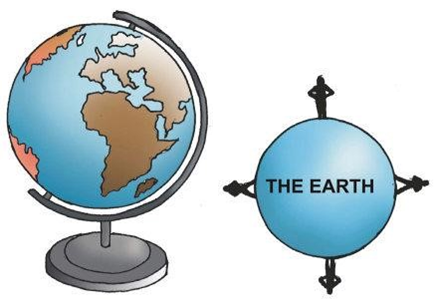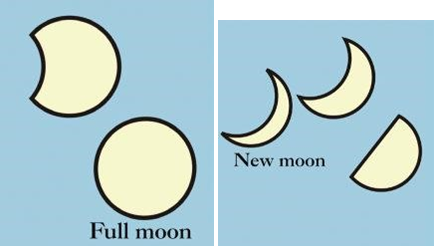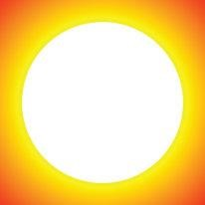Lesson Notes By Weeks and Term - Primary 6
THE EARTH'S MOVEMENT AND ITS EFFECTS
WEEK 6
SUBJECT: BASIC SCIENCE AND TECHNOLOGY
TERM: 1ST TERM
CLASS: PRIMARY 6
TOPIC: THE EARTH’S MOVEMENT AND ITS EFFECTS
BEHAVIOURAL OBJECTIVES: AT THE END OF THE LESSON, PUPILS SHOULD BE ABLE TO:
INSTRUCTIONAL MATERIALS:
A chart showing the movement of the earth
REFERENCE MATERIALS
Scheme of work
All relevant materials
9-Years Basic Education Curriculum
Online information
BUILDING BACKGROUND/CONNECTION TO PRIOR KNOWLEDGE:
Pupils are familiar with the topic in their previous classes.
CONTENT OF THE LESSON
The study of the universe has led to the discovery of the planets, the stars, the gases and other things. The earth is one of the nine planets of the solar system. It is the planet in which life exist. It consists of three parts and it is spherical in shape.
The earth rotates from the West to the East as if it is being turned on an imaginary line passing through its centre. This imaginary line is called the earth's axis. This rotation of the earth about its axis causes day and night. It was discovered that when the earth' rotates, since it is spherical, only one half of it faces the sun, 'and it is day time in countries on that part of the earth. The other side which does not receive the light from the sun, at that time, is dark and it is night time in such places. The earth makes one' complete rotation about its axis in twenty-four hours.

Revolution of the Earth Round the Sun
At the same time as the earth rotates on its axis, it also revolves round the sun. The movement of the earth round the sun is called the revolution of the earth.
As mentioned earlier, the movement of the earth round the sun is called the revolution of the earth.
The earth revolves round the sun in about 365 days or in one year. The path of the earth round the sun is not a circle. It is a (geometrical) shape called an ellipse.
The Effect of the Revolution of the Earth
The seasons
The revolution of the earth round the sun makes it possible for some parts of the earth to receive more sunlight than other parts at a given time. There are two major seasons in Nigeria namely: wet season and dry season. Between the months of October and February, the weather is very hot and dry. This is called the dry season. This means that a large amount of the sun's rays reaches Nigeria during this period of the earth's Revolution.
Between the months of March and September, there is a lot of rainfall. The weather is cooler and windy. This is the wet season. It is noteworthy that between the months of December and February, there is a special period during the dry season, when the weather is hot and dry during the day, yet it is very cold at night and in the early mornings. This is the harmattan period.
All these changes in the seasons are caused by the revolution of the earth round the sun. This revolution of the earth round the sun is from East to West.
The Cardinal Points
The earth is divided into four cardinal points or main bearings on a compass. These are: East, West, North and South. The compass is used to find directions based on these points.
Eclipses
There are two types of eclipses: an eclipse of the sun and an eclipse of the moon


Activity
Materials
A candle, matches, a football, tennis or a ping-pong ball and a piece of cardboard.
Arrange a lighted candle, a tennis or a ping-pong ball and cardboard paper in a straight line, in a dark room (close the windows of your classroom). Look at the cardboard paper. What do you observe?
You will observe that a shadow of the ball falls on the cardboard at B. This is because light is not reaching it at that point. The sections A and C which are very close to B receive very small amounts of light. The ball is an opaque object, and it blocks the light of the candle from reaching the cardboard at B.
(iii) Show the part of the earth that has very bright light.
Eclipse of the Moon
An eclipse of the moon occurs when the earth comes in between the sun and the moon.
With the candle light representing the sun, the football representing the earth and the tennis or ping pong ball representing the moon, draw a diagram to show the eclipse of the moon.

Solar System
The solar system comprises the sun and all the bodies (planets, satellites and other objects) moving round it.
There are nine planets which revolve round-the sun. Each planet has its own path. The planets are: (i) Mercury, (ii) Venus, (iii) Earth, (iv) Mars, (v) Jupiter, (vi) Saturn, (vii) Uranus, (viii) Neptune and (ix) Pluto.
Note: Pluto is much smaller than any of the official planets and now classified as a' dwarf planet'.
The path along which each planet moves round the sun is called its orbit. We should note that the sun is a star, it produces light. Stars are objects in space, which produce light.
The Planets
The planets are not stars, so they do not produce light like the sun. They are seen at night because they reflect light from the sun. The planets may appear like bright stars to us at night because they are much nearer to us than any star. Any bright object in the sky that does not twinkle at night is a planet.
The distance of the earth from the sun is about 150 million kilometres and as we already know, it travels round the sun in 365 days. The table below shows the distance of each planet from the sun. It also shows the time it takes each planet to travel round the sun and the number of moons the planet has.
Satellites
We have learnt that the moon moves round the earth. The moon is therefore a satellite of the earth. he bodies at move around the planets are called satellites.
Scientists have also constructed objects which move round the earth; these objects are called artificial satellites. These satellites receive radio and television messages from one part of the world and convey them to another part of the world. Some satellites take very accurate pictures of locations and objects on the earth. They normally travel from the West to the Eost, and appear as tiny stars at night.
Stars
The sun is a star and it is about 150 million kilometers away from our earth. Stars twinkle and because they are far away, they look like tiny points of light. The nearest star to the earth is forty -three million kilometres away. Look at the sky at night. You might notice some groups of stars that show very clearly. These stars can be seen more easily in the tropics in late evening by months of January and February and in the early morning of September and October. They can also be seen clearly at midnight.

A scientist who studies heavenly bodies which includes stars is called an astronomer. Astronomers use special equipment like telescopes to observe these heavenly bodies.
If you observed the sky carefully you would see that the stars are not all the same colour. The hottest ones like Rigel appear blue. Those that are not so hot appear white, while cooler stars look yellow. The coolest stars like Betelguse seem to have a red Colour.
Assessment & Evaluation:
(WRAP-UP CONCLUSION)
Teacher goes over the topic once again to enhance better understanding
© Lesson Notes All Rights Reserved 2023